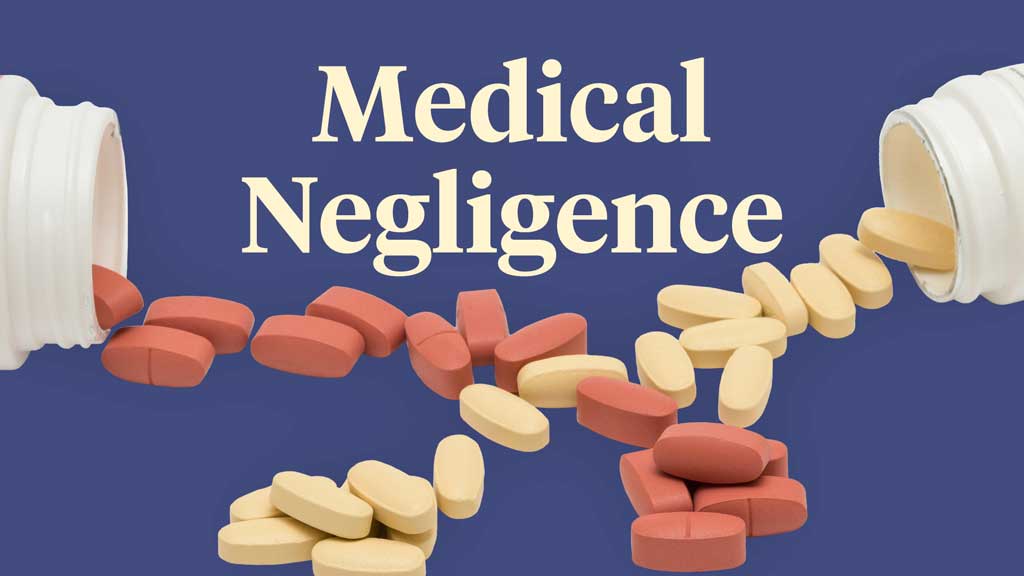Under common law, healthcare professionals have a duty of care towards their clients. Breaching this may result in negligence (LSC 2013a).
Note: Australian legislation relating to negligence is mostly aligned, however, small differences do exist between each state and territory. Always refer first to your jursidiction’s legislation and organisation’s policies on negligence and duty of care. A list of further resources can be found below.
Note: This article is related to civil negligence.
What is Medical Negligence?
Negligence can be defined as a failure to take reasonable care or steps to prevent loss or injury to another person. In healthcare, negligence occurs when a healthcare professional fails to take reasonable care or steps to prevent loss or injury to a client (Caxton Legal Centre 2023).
Being negligent is not the same as making a mistake or error of judgement. Even if a particular risk eventuates, or a desired outcome is not achieved, this does not necessarily mean negligence has occurred. This is particularly true in healthcare, as most medical interventions have risks and complete safety can rarely be guaranteed (LSC 2013b; Caxton Legal Centre 2023).
Negligence may occur during any aspect of healthcare. Examples include:
- History taking
- Giving medical advice
- Examinations
- Testing
- Reporting acting on results of tests
- Giving treatment.
(LSC 2013b)

The Four Principles of Negligence
In order for a healthcare professional to be found negligent, these four principles must be proven:
- Duty of care: The healthcare professional had a duty of care towards the client in the given situation.
- Breach of duty: The healthcare professional, through action or inaction, did not meet the standard of care that another healthcare professional would reasonably meet in the same situation.
- Damage: The client experienced injury or loss that a reasonable person would have been able to foresee in the same situation.
- Causation: The damage or loss was caused by the breach of duty.
(LSC 2013b; Hobart Community Legal Service 2017; HCC 2017)
Duty of Care
As a recognised part of their professional relationship, healthcare staff owe a duty of care towards the safety and wellbeing of their clients. This duty of care means healthcare professionals are expected to provide treatment and advice to clients with reasonable care and skill (Caxton Legal Centre 2018, 2023).
Healthcare professionals are also obligated to take reasonable steps to prevent foreseeable harm from occurring to clients (Caxton Legal Centre 2023; Slater and Gordon 2015).
Breach of Duty
When determining whether there has been a breach of duty, a standard of care needs to be established. The healthcare professional’s action (or inaction) will then be compared to this standard. If the healthcare professional’s action in the given situation differed to the established standard of care, then they may be liable for negligence (LSC 2013b).
The standard of care is based on what a reasonably competent healthcare professional would have done in the same situation (LSC 2013b).
This involves determining:
- Whether a reasonably competent healthcare professional would have been able to predict the risk of harm
- Whether the risk was significant, and
- Whether a reasonably competent healthcare professional would have taken precautions against the risk.
(Hobart Community Legal Service 2017; Caxton Legal Centre 2018)
When determining whether a reasonably competent healthcare professional would have taken precautions, the court considers:
- The likelihood of the harm occurring if precautions were not taken
- How serious the harm was likely to be
- The burden of taking precautions to avoid the risk of harm, and
- The possible net benefits of the activity that exposed others to the risk of harm.
(Hobart Community Legal Service 2017; Caxton Legal Centre 2018)
It is important to note that the standard of care is set by the court. This means that even if a particular practice is common or accepted by other healthcare professionals, the court may still consider it negligent (LSC 2013b).
For example, if it is common practice in a workplace to give medications two hours late, a nurse may still be found negligent because the standard of care is that patients receive their medications in a timely manner. Although this is a simplistic explanation, it serves to illustrate standards of care.
Breaches of duty that may occur in healthcare include:
- Misdiagnosis or failure to diagnose
- Delayed diagnosis
- Overlooking or failing to recognise symptoms
- Failing to warn the client about risks
- Incorrect prescription or administration of medicines
- Surgical mistakes such as:
- Operating on the wrong site or client
- Performing the wrong procedure
- Leaving surgical equipment in the body
- Damaging organs, nerves or tissue
- Failing to follow postoperative infection control procedures
- Failure to control bleeding
- Using surgical equipment that is not sterile
- Failure to monitor vital signs during a procedure
- Performing procedures unsafely
- Anaesthesia mistakes such as administering too much anaesthesia, failing to inform the client about safety procedures or using faulty equipment
- Prenatal and childbirth mistakes such as failing to diagnose birth defects or failing to diagnose medical conditions that may affect pregnancy
- Inadequate care before or after a procedure
- Failing to take the client’s medical history into account.
(Schreuders 2022; DeSalvo Law 2022; Choahan 2018)

Damage
The type of damage or loss experienced by a client will depend on the circumstances, but examples include:
- Illness worsening or progressing
- Medical, treatment and hospital costs
- Legal costs
- Loss of income
- Pain and suffering
- Loss of ability to earn money in the future
- Loss of enjoyment of life
- Infection
- Injury
- Permanent disability or disfigurement
- Harm or death to an infant and/or mother during childbirth
- Death.
(Schreuders 2022; DeSalvo Law 2022; HCC 2017)
Causation
Even if it is established that the healthcare professional has a duty of care, a breach of duty has occurred and the client has experienced damage or loss, the harm needs to be directly linked to the breach of duty. If it cannot be proven that the harm only occurred due to the breach of duty (and would not have occurred on its own irrespective of the breach), the health professional will not be found negligent (Choahan 2018).
What is Reasonable?
These principles of negligence revolve around the concept of being ‘reasonable’: healthcare professionals are expected to take reasonable care of clients, their actions are compared to what another healthcare professional in the same situation would reasonably do, and damage caused by negligence is harm that a reasonable person would have been able to foresee.
What exactly does ‘reasonable’ mean, though?
‘Reasonable’ is a hypothetical standard where a situation is approached with an appropriate amount of caution, and a sensible action is taken in response to the situation. Reasonable does not mean perfect; in fact, some mistakes may still be considered reasonable, depending on the circumstances. In some situations, accidents or mistakes may even be unavoidable (New York Personal Injury Attorneys 2020).
For example, a client who receives chemotherapy and reacts to the medication cannot hold a nurse responsible for their allergic reaction; however, if the nurse giving the chemotherapy treatment failed to respond appropriately to the allergic reaction, they can be held responsible (i.e. if the nurse failed to recognise the signs and symptoms of an allergic reaction and did not notify the doctor, the nurse could be found negligent, as the standard of care is that a nurse should recognise when a patient is having an adverse reaction and would be expected to act accordingly).

Challenges of Medical Negligence
Clients may have difficulty proving negligence for a few reasons:
- Due to the inherent risks associated with most healthcare procedures, negligence may not be proven even if harm or an undesired outcome has occurred.
- The judgement of negligence is based on the opinions of qualified experts (rather than the healthcare professional and client involved), who may disagree on the standard of care or cause of harm.
- It may be difficult to determine what the client’s state of health would be if the issue did not occur, as the client may not have undergone a procedure at all if correct duty of care was taken.
(Caxton Legal Centre 2023)
Conclusion
Medical negligence is a complicated legal situation. If you find yourself involved in negligence proceedings, you will need to understand the principles of negligence.
Australian State and Territory Legislation:
- Australian Capital Territory
- New South Wales
- Northern Territory
- Queensland
- South Australia
- Tasmania
- Victoria
- Western Australia
Test Your Knowledge
Question 1 of 3
What are the four principles of negligence?
Topics
References
- Caxton Legal Centre 2018, ‘Duty of Care’, The Queensland Law Handbook, viewed 11 October 2023, https://queenslandlawhandbook.org.au/the-queensland-law-handbook/health-and-wellbeing/accidents-and-injury/duty-of-care/
- Caxton Legal Centre 2023, ‘Medical Negligence’, The Queensland Law Handbook, viewed 11 October 2023, https://queenslandlawhandbook.org.au/the-queensland-law-handbook/health-and-wellbeing/medical-law/medical-negligence/
- Choahan, N 2018, Medical Negligence: ‘What GPs Need to Know’, NewsGP, 16 August, viewed 11 October 2023, https://www1.racgp.org.au/newsgp/professional/medical-negligence-what-gps-need-to-know
- DeSalvo Law 2022, Examples of Medical Malpractice? These are the 7 Most Common, DeSalvo Law, viewed 11 October 2023, https://desalvolaw.com/medical-malpractice/examples-of-medical-malpractice/
- Health Complaints Commissioner 2017, Medical Negligence, Victoria State Government, viewed 11 October 2023, https://www.hcc.vic.gov.au/sites/default/files/media-document/hcc_fact_sheet_02_-_medical_negligence_0.pdf
- Hobart Community Legal Service 2017, ‘Negligence and Duty of Care’, Tasmanian Law Handbook, viewed 11 October 2023, https://www.hobartlegal.org.au/handbook/accidents-and-insurance/negligence/negligence-and-duty-of-care/
- Legal Services Commission South Australia 2013a, ‘Medical Negligence’, Law Handbook, viewed 11 October 2023, https://lawhandbook.sa.gov.au/print/ch29s06.php
- Legal Services Commission South Australia 2013b, ‘What is Negligence?’, Law Handbook, viewed 11 October 2023, https://lawhandbook.sa.gov.au/ch29s06s01.php
- New York Personal Injury Attorneys 2020, What is Considered a “Reasonable Person” When it Comes to Negligence?, New York Personal Injury Attorneys, viewed 11 October 2023, https://www.triallaw1.com/what-is-considered-a-reasonable-person-when-it-comes-to-negligence/
- Schreuders 2022, 5 Common Examples of Medical Negligence Cases, Schreuders, viewed 11 October 2023, https://schreuders.com.au/common-examples-of-medical-negligence-cases/
- Slater and Gordon 2015, What is Duty of Care?, Slater and Gordon, viewed 11 October 2023, https://www.slatergordon.com.au/personal-injury/public-liability/what-is-duty-of-care
 New
New 
